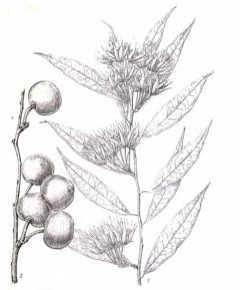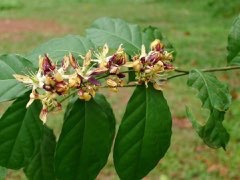 |
|
http://www.edibleplants.org |
 |
| Scamperdale flickr.com |
Translate this page:
Summary
Pentadiplandra brazzeana or commonly known as Joy Perfume Tree is a tropical plant that has two forms - it can be a small and climbing plant that can be up to 20 m long or a well-branched shrub that can be up to 5 m tall. It is the only species in the Pentadiplandra genus and it can be found in Africa. The roots are used medicinally to treat a wide range of conditions that are mostly related to childbirth and skin problems. Decoction of the leaves is used against scabies. The fruits are edible. It is a globose berry with a sweet and red pulp. The root is occasionally eaten as a vegetable.
Physical Characteristics

 Pentadiplandra brazzeana is an evergreen Climber growing to 12 m (39ft) by 0.5 m (1ft 8in) at a fast rate.
Pentadiplandra brazzeana is an evergreen Climber growing to 12 m (39ft) by 0.5 m (1ft 8in) at a fast rate.
See above for USDA hardiness. It is hardy to UK zone 10.
Suitable for: light (sandy), medium (loamy) and heavy (clay) soils and prefers well-drained soil. Suitable pH: mildly acid, neutral and basic (mildly alkaline) soils. It cannot grow in the shade. It prefers moist soil.
UK Hardiness Map
US Hardiness Map
Synonyms
Cercopetalum dasyanthum Gilg Pentadiplandra gossweileri Exell
Plant Habitats
Edible Uses
Edible Parts: Fruit Root
Edible Uses: Condiment Sweetener
Fruit - raw or as a flavouring[299]. The red pulp is eaten as a snack, especially by children, or is sometimes used to sweeten maize porridge[299 ]. The red or mottled grey fruit is a globose berry 35 - 50mm in diameter, containing many seeds[299 ]. The protein brazzein, originally extracted from the fruit pulp, [299 ]. An extremely sweet crude protein, named pentadin, has been isolated from the fruits; in the 1990's the purified protein was isolated and called brazzein. Its temporal profile closely resembles that of sucrose, but develops somewhat more slowly and lasts longer. It is very thermo-stable and its sweetness profile does not diminish after incubation at 100°c for 4 hours. It is also stable over a wide pH range and is the most water-soluble protein sweetener discovered so far. Brazzein is reported to be between 500 and 2,000 times sweeter than sucrose depending on the method of measuring. It is being developed into a low-calorie sweetener for the food industry - however, as of early 2008, brazzein had not yet been granted GRAS (generally recognized as safe) status in the United States nor had it been granted permission for use in foods in the European Union[299 ]. The root is reportedly occasionally eaten as a vegetable[299 ]. The powdered root bark is said to be an ingredient of the cheap but dangerous 'African whiskey in sachets'[299 ].
References More on Edible Uses
Medicinal Uses
Plants For A Future can not take any responsibility for any adverse effects from the use of plants. Always seek advice from a professional before using a plant medicinally.
Abortifacient Anthelmintic Antibacterial Antihaemorrhoidal Antirheumatic Antiseptic Aphrodisiac Cathartic
Dysentery Emmenagogue Epilepsy Laxative Malaria Parasiticide Purgative
Skin Vesicant
The roots, which taste like horseradish, are used throughout central Africa to treat a wide range of conditions, but particularly to remedy several problems related to giving birth and also to deal with a range of skin problems[299 ]. Phytochemical analyses of the root have led to the isolation of urea derivatives including sulphur-containing compounds[299 ]. Carbamates obtained from the roots have shown antibacterial properties in vitro against Staphylococcus aureus, Escherichia coli, Klebsiella pneumoniae and Pseudomonas aeruginosa, and against the yeast Candida albicans[299 ]. The root is also rich in glucosinolates and is believed to contribute to the revitalizing of collagen and to restore skin tonicity[299 ]. Crude extracts of tubers have revealed moderately strong antiplasmodial activity in vitro, but were not as effective as chloroquine[299 ]. An aqueous extract of the root given to rats increased the weight of their testes and prostate as well as their testosterone levels[299 ] The roots are antibacterial, aphrodisiac, cathartic, emmenagogue, laxative, purgative. They are widely used by women to assist in the birth process and also to deal with problems related to the uro-genital system. A root decoction can stimulate uterine contractions and has been used to induce abortion - it should generally be avoided by pregnant women until the later stages of the pregnancy[299 ]. A root decoction is given orally, or applied as an enema, to facilitate the expulsion of the placenta, and is also said to prevent haemorrhages after parturition[299 ]. The root bark is one of more than 20 constituents of the yellow, slimy 'nkui' sauce made by the Bamileke people of Cameroon; this sauce is given to mothers who have just given birth in order to stimulate milk production. A root decoction is given orally or applied as an enema to help in reducing pain caused by hernia[299 ]. The crushed root or root bark is applied, or an infusion drunk, to soothe chest pain, toothache, lumbago, rheumatism and haemorrhoids. The macerated roots, either alone or mixed with other ingredients, are taken orally or applied as an enema against malaria. Capsicum pepper is added to macerated roots to prepare a drink that soothes cough. A decoction of the bark, combined with the bark and roots of other plants, is taken as a treatment against stiffness or weakness of the limbs and back. The roots and tubers are also commonly used in the treatment of intestinal problems such as dysentery, colic, urethritis, gonorrhoea and other uro-genital infections[299 ]. A decoction of the tuber, as well as the juice from macerated roots, is combined with pounded leaves and drunk as an anthelmintic. A root decoction is taken to treat pneumonia and serious bronchitis[299 ]. The fresh root is pulped, or the dry root pounded and mixed with palm oil, to make an ointment for topical application to prevent infections of the navel in newborn babies. Because the plant is vesicant, the duration of this treatment must be limited to avoid blistering[299 ]. A powder of dried root bark is applied to scarifications to treat intercostal and abdominal pains. The crushed root is used to treat several skin infections. The pulped roots are applied externally against itch and as an antiseptic, and to treat wounds, sores, ulcers and furuncles[299 ]. The roots are applied to the abdomen to treat oedema[299 ]. A root preparation, combined with the leaves of Kalanchoe crenata, is used as nose drops to stop epileptic crises[299 ]. A leaf decoction is used to wash the skin against scabies[299 ].
References More on Medicinal Uses
The Bookshop: Edible Plant Books
Our Latest books on Perennial Plants For Food Forests and Permaculture Gardens in paperback or digital formats.

Edible Tropical Plants
Food Forest Plants for Hotter Conditions: 250+ Plants For Tropical Food Forests & Permaculture Gardens.
More

Edible Temperate Plants
Plants for Your Food Forest: 500 Plants for Temperate Food Forests & Permaculture Gardens.
More

More Books
PFAF have eight books available in paperback and digital formats. Browse the shop for more information.
Shop Now
Other Uses
Parasiticide Repellent Teeth
Other Uses The roots smell of aspirin and are hung over the doorway or are placed inside the roof to keep away snakes[299 ].
Special Uses
References More on Other Uses
Cultivation details
The flowers can be single-sex or bisexual[299 ]. The flowering period continues for several months; fruit production is normally low and spread out, though shrubby plants seem to have a shorter but more condensed fruiting season[299 ]. Unconsumed fruits rot on the plant, without falling. They serve as temporary nesting sites to arboreal ants[299 ]. Seed dispersal is facilitated by the contrast between the extreme sweetness of the pulp of the fruit and the unpleasant bitter taste of seeds, provoking consumers to spit out the seeds. In natural habitats, squirrels, monkeys and apes contribute to the distribution of the seed; in the vicinity of human habitation, distribution by children into secondary habitats is common[299 ]. Commercial interest in brazzein, the protein obtained from the fruit, is strong. The technology to extract the protein from the fruit pulp as well as technologies to produce brazzein by transferring the gene coding for brazzein into other organisms have been patented, without the intention of benefit sharing[299 ]. The gene encoding for brazzein has been transferred to the bacteria Escherichia coli and Lactococcus lactis and to maize. Bacterial production systems for brazzein have been developed. Mutants and sections of brazzein have been discovered with sweet-taste properties superior to those of the natural protein[299 ].
References Carbon Farming Information and Carbon Sequestration Information
Temperature Converter
Type a value in the Celsius field to convert the value to Fahrenheit:
Fahrenheit:
The PFAF Bookshop
Plants For A Future have a number of books available in paperback and digital form. Book titles include Edible Plants, Edible Perennials, Edible Trees,Edible Shrubs, Woodland Gardening, and Temperate Food Forest Plants. Our new book is Food Forest Plants For Hotter Conditions (Tropical and Sub-Tropical).
Shop Now
Plant Propagation
Seed -
Other Names
If available other names are mentioned here
Joy perfume tree, j'oubli, Amelalokulu, Digabi, Etekele, Mandangela, Ophana, Tophanda, i'oubli, oubli.
Native Range
AFRICA: Cameroon, Democratic Republic of the Congo, Gabon, Angola (Cabinda)
Weed Potential
Right plant wrong place. We are currently updating this section.
Please note that a plant may be invasive in one area but may not in your area so it's worth checking.
Conservation Status
IUCN Red List of Threatened Plants Status : This taxon has not yet been assessed

Growth: S = slow M = medium F = fast. Soil: L = light (sandy) M = medium H = heavy (clay). pH: A = acid N = neutral B = basic (alkaline). Shade: F = full shade S = semi-shade N = no shade. Moisture: D = dry M = Moist We = wet Wa = water.
Now available:
Food Forest Plants for Mediterranean Conditions
350+ Perennial Plants For Mediterranean and Drier Food Forests and Permaculture Gardens.
[Paperback and eBook]
This is the third in Plants For A Future's series of plant guides for food forests tailored to
specific climate zones. Following volumes on temperate and tropical ecosystems, this book focuses
on species suited to Mediterranean conditions—regions with hot, dry summers and cool, wet winters,
often facing the added challenge of climate change.
Read More
Expert comment
Author
Baill.
Botanical References
Links / References
For a list of references used on this page please go here
A special thanks to Ken Fern for some of the information used on this page.
Readers comment
| Add a comment |
|
If you have important information about this plant that may help other users please add a comment or link below. Only comments or links that are felt to be directly relevant to a plant will be included. If you think a comment/link or information contained on this page is inaccurate or misleading we would welcome your feedback at [email protected]. If you have questions about a plant please use the Forum on this website as we do not have the resources to answer questions ourselves.
* Please note: the comments by website users are not necessarily those held by PFAF and may give misleading or inaccurate information.
To leave a comment please Register or login here All comments need to be approved so will not appear immediately.
|
Subject : Pentadiplandra brazzeana
|
|
|
|